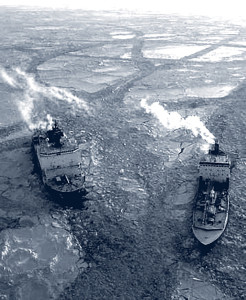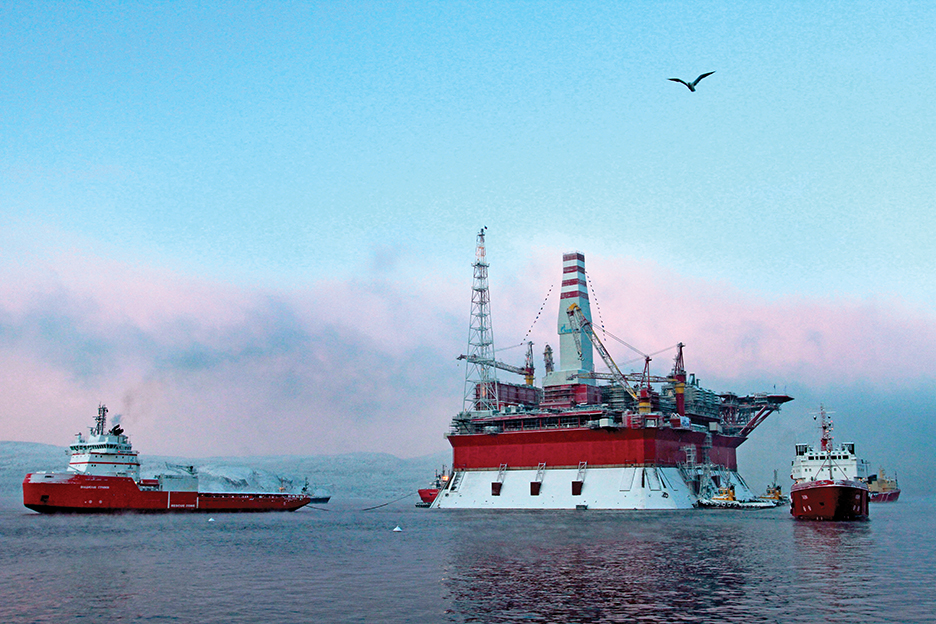Shrinking ice caps require nations to cooperate in sharing polar resources
By per Concordiam Staff
In September 2014, the MV Nunavik, a Canadian icebreaking cargo ship, landed at Sachs Harbor in Canada’s Northwest Territory, having just finished transiting the fabled Northwest Passage through the Arctic Ocean. The Nunavik, owned by Fednav shipping company, was the first cargo ship in recent memory to complete the passage unaided by icebreakers.
The passage of the MV Nunavik is a milestone in the opening of the Arctic. The Arctic ice cap has been gradually shrinking since the 1950s, but the process has been accelerating since the mid-1990s, says the U.S. National Snow and Ice Data Center (NSIDC). Less ice makes more of the Arctic accessible for longer periods, which means the region’s rich natural resources will be easier to reach and shipping lanes will be open longer, promising potential transportation savings of hundreds of million dollars annually. But the activity needed to access these resources could degrade the environment and damage wildlife habitats.
The opening of the Arctic has drawn the attention of the five littoral countries — Canada, Denmark (through Greenland), Norway, Russia and the United States — and the neighboring Arctic states of Finland, Iceland and Sweden. But it also has attracted countries such as China, whose growing export-driven economy hungers for energy and would benefit from shorter sea routes. Potential rivalries over Arctic riches have raised concerns of a new Cold War developing in the region.

PETTY OFFICER 1ST CLASS SARA FRANCIS/U.S. COAST GUARD
Natural Abundance
The Arctic holds plentiful untapped energy, but nobody is certain exactly how much. The most recent assessment by the U.S. Geological Survey in 2008 estimated the region contains 90 billion barrels of oil, 1,669 trillion cubic feet of natural gas and 44 billion barrels of natural gas liquids, amounting to 13 to 20 percent of the world’s undiscovered oil and natural gas reserves. Even more oil, up to 160 billion barrels, could reside mostly offshore under permanent or seasonal ice caps.
Even in ideal conditions, drilling offshore is riskier and costlier than drilling on land. In extreme Arctic offshore conditions, the difficulties are multiplied. Even onshore, extraction costs could be double what they are in Texas, the U.S. Energy Information Administration reported in 2012. Royal Dutch Shell, the first company to receive offshore Arctic drilling permits from the U.S. government, ran into numerous problems in the Beaufort and Chukchi seas off Alaska in 2012 and had to shut down operations. This confirmed to critics that “the company and its federal partners had not shown that they had the equipment, skill or experience to cope with the unforgiving environment there,” The New York Times wrote in January 2013.
Environmental Concerns
The NSIDC says the ice cap is shrinking 3 to 4 percent per decade. If aggressive climate change models are accurate, the polar ice cap could shrink to the point that the region’s ecological balance is threatened. Some models predict summers will be partially ice free by 2050. Scientists believe that a shrinking ice cap accelerates global warming because the snow and ice provide a cold, reflective layer against solar heating.
Environmentalists are equally concerned about an oil spill in such a remote area of the world. In cold water, the oil won’t break down as quickly as in warmer waters. If the oil spreads under the ice, no one knows how it will behave, said Dr. Simon Boxall, an oceanographer at the University of Southampton in the United Kingdom.
Energy experts think such challenges can be overcome, pointing to successful operations in other hazardous areas. “The oil and gas industry is renowned for developing technologies and methods needed to safely explore for and produce oil and natural gas in the heat of the Middle East, the storms of the North Sea, and the ultra-deep finds in the Gulf of Mexico and Brazil,” Randall Luhti, president of the National Ocean Industries Association, told the National Journal’s “Energy Insiders” in August 2014. “Certainly development in the Arctic will require extra care, and perhaps added technological innovation, but yes, it is possible to do it safely.”

Energy Economics
The plunge in oil prices since late 2014 have made the Arctic less attractive as a source of energy, at least in the short run. Oil prices need to exceed $80 per barrel to make offshore drilling in the Arctic cost effective, said Foster Mellen, a global oil and gas analyst with the consulting firm Ernst & Young. Prices were about half that level in the fall of 2015 and were projected to stay low through at least 2016.
By early 2015, several energy companies began backing away from Arctic projects. Alaska Public Media reported: “Chevron decided to stop seeking government approval to work north of Canada. And over in Greenland, Statoil gave back three of its four licenses to drill offshore.” Even Russia has pulled back. Plans for a major natural gas terminal in the town of Teriberka were shelved as uneconomical after the country’s international energy partners pulled out, The New York Times reported in August 2015. Shell, however, restarted drilling in the Chukchi Sea in late July 2015 after receiving approval from the U.S. government.
But Western nations and their energy companies may have to move into the Arctic regardless of oil prices to stake their claims in an international race for control of one of the Earth’s last frontiers. “If the West fails to tap these riches quickly, then Russia will have no such reservations,” The Telegraph noted.
Russia already has begun ambitious projects in the Arctic. According to Financial Times, Russian gas company Novatek is developing a $27 billion liquid natural gas project in the Arctic, and Russian oil company Rosneft and ExxonMobil have been jointly drilling in the Kara Sea off Russia’s northern coast.
The Council on Foreign Relations, a U.S. international relations think tank, says Russia has emerged as the dominant player in the region as a result of investing tens of billions of dollars in infrastructure. In 2013, Russia began reopening shuttered Arctic military facilities and building new ones. China also is interested in claiming a stake by improving relations with regional powers such as Norway and Denmark. Online news site Business Insider says that China invests heavily in Greenland mining and has struck a deal with Russian petroleum company Rosneft to collaborate in offshore Arctic oil, and Chinese naval vessels are venturing into Arctic waters. The U.S. has taken notice. In September 2015, U.S. President Barack Obama announced plans to revitalize America’s Arctic presence with the construction of new icebreakers and charting initiatives to replace outdated maps and charts of the Bering, Chukchi and Beaufort seas.
Northwest Passage
The MV Nunavik arrived in the port of Bayuquan, China, with its cargo of 23,000 tons of nickel ore 26 days after leaving Deception Bay, Canada. The Northwest Passage route is 40 percent shorter than the route through the Panama Canal and, according to Fednav, saves enough fuel to reduce carbon emissions by 1,300 metric tons. The Nordic Orion, a Danish-operated bulk carrier that made the passage in 2013 with an icebreaker escort, saved 1,000 nautical miles and $200,000 transporting coal from Vancouver, British Columbia, to Pori, Finland, according to Canada’s The Globe and Mail. These shipping lanes are not only shorter than the Panama Canal route, but deeper: The Nordic Orion was able to load 25 percent more cargo, boosting efficiency. Russia also has been developing its own Arctic route — the Northern Sea Route, which skirts the Siberian coast — relying on its unique fleet of nuclear-powered icebreakers. China has shown great interest in using the route to ship exports to Europe.

Regional Cooperation
As the Arctic becomes more accessible to energy exploration and shipping, nations of the Arctic littoral and other interested parties will need to improve cooperation. The United Nations has been invested with special responsibility through the UN Convention on the Law of the Sea, by which the five Arctic states have agreed to settle any overlapping claims to territorial resource rights.
Several multilateral organizations focus on Arctic issues. The International Maritime Organization is a 171-member-state, UN-chartered agency “with responsibility for the safety and security of shipping and the prevention of marine pollution by ships.” The Arctic Council, established in 1996 by the eight nations with territory above the Arctic Circle, is an intergovernmental forum to promote cooperation on the environment, but some view it as the ideal format to address resource rights, trade routes and militarization.
As the Pew Foundation concluded in a 2014 review of development risks: “The Arctic is remote, extreme, and vulnerable. To achieve a balance between responsible energy development and protection of important biological and cultural areas, it is essential that appropriate standards and protections be in place first.” Regardless of format, international cooperation is essential to preserve the Arctic’s unique environment and avoid conflict while taking advantage of emerging opportunities.


Comments are closed.